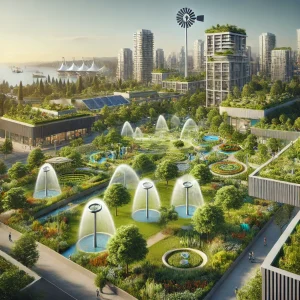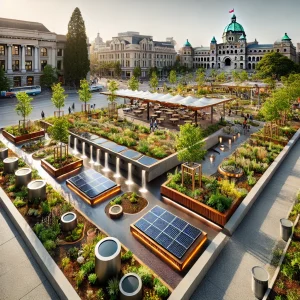As we approach 2025, city design and development are being profoundly transformed. In places like Victoria and British Columbia, urban landscapes are evolving beyond aesthetics to become functional, sustainable spaces that address environmental, social, and economic needs. Integrating green technology and creative design solutions drives this evolution, allowing cities to balance development with nature.

Embracing Green Technology in Victoria
Victoria has become a hub for green innovation, setting the standard for urban landscaping across British Columbia. Key technologies such as smart irrigation systems, renewable energy sources, and biophilic design are redefining how public and private spaces are created.
One notable example is Victoria’s Beacon Hill Park, where smart irrigation systems efficiently manage water use. These systems use sensors to monitor soil moisture and weather conditions, automatically adjusting water delivery to plants, significantly reducing water waste. This approach conserves resources and ensures plant health, promoting sustainability in a city committed to environmental stewardship.
Renewable energy is also pivotal in transforming city spaces. In the Dockside Green development, solar panels and wind turbines are integrated into the landscape design. These technologies provide clean energy to surrounding buildings while seamlessly blending into the aesthetic of green spaces. Combining renewable energy with eco-friendly materials sets a new standard for future urban development.
Biophilic Design: Bringing Nature into the City
Biophilic design is another trend shaping Victoria’s urban landscapes. This approach connects city dwellers with nature by incorporating natural elements into built environments. Victoria’s Atrium Building is a prime example of how biophilic design creates a healthier and more pleasant urban space. The building features large indoor gardens, vertical green walls, and open spaces filled with natural light. Not only does this enhance the aesthetic appeal, but it also improves air quality and fosters a sense of well-being for visitors and residents.
Another innovative project is The RailYards development, where green rooftops, water-efficient landscaping, and the use of local plant species promote biodiversity while reducing the heat island effect in the urban core. This fusion of nature with modern infrastructure exemplifies how biophilic design softens urban landscapes while promoting sustainability.

Public Spaces and Private Developments Leading the Way
Victoria is taking bold steps in both public and private projects to showcase what future city landscapes might look like. Centennial Square is another shining example of a public space utilizing green technologies. The square features drought-resistant plants, solar-powered lighting, and a rainwater collection system that supports the landscape’s irrigation needs. These innovative design solutions ensure the space remains environmentally friendly while reducing long-term maintenance costs.
In the private sector, projects like The Hudson District are reimagining how residential areas incorporate green technology. Smart lighting systems that adjust based on natural light conditions, energy-efficient landscaping, and rooftop gardens are just a few features defining this development. Incorporating sustainable materials and energy-efficient design elements makes these private developments key players in Victoria’s future urban landscaping.

Benefits, Challenges, and the Future of Urban Landscaping
The transition from traditional to modern urban landscaping brings numerous benefits. By leveraging green technologies, cities like Victoria can create eco-friendly spaces that are not only visually appealing but also reduce resource consumption and enhance biodiversity. These innovations also foster healthier environments for residents, improving air quality and providing spaces for physical activity and relaxation.
However, these advancements come with challenges. Implementing green technology in urban landscaping requires substantial upfront investment, and not all projects may see immediate returns. Maintaining these advanced systems over time is challenging, as is ensuring the necessary expertise and resources are available.

Looking ahead to 2025, the trend toward sustainable urban development will likely accelerate. Cities like Victoria are expected to continue integrating smart systems, renewable energy, and biophilic design into public and private projects, fostering a closer relationship between urban life and nature. As more cities worldwide look to Victoria for inspiration, the future of urban landscaping promises to be more resilient, adaptable, and environmentally conscious.
Victoria, British Columbia, stands at the forefront of urban landscaping innovation. The city’s commitment to integrating green technology and creative design solutions into public spaces and private developments sets a clear path for the future of sustainable cityscapes. As 2025 approaches, Victoria serves as a model for how cities can embrace these advancements, creating urban environments that are not only beautiful but also sustainable and functional for future generations.
